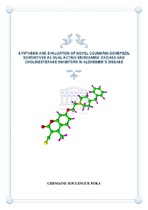| dc.description.abstract | Alzheimer's disease is a progressive neurodegenerative disease characterised by low acetylcholine (ACh) levels in the hippocampus and cortex of the brain, causing symptoms like progressive memory loss, decline in language skills and other cognitive impairments to occur. The hallmarks of AD include the presence of extracellular insoluble amyloid beta plaques, intracellular neurofibrillary tangles, and the decrease in ACh concentration. The pathophysiology of AD is not well understood, however, acetylcholinesterase (AChE), butyrylcholinesterase (BuChE) and monoamine oxidases (MAO) are conspicuous role players in AD pathogenesis. Based on the cholinergic hypothesis, the AChE inhibitor donepezil was developed and has been used effectively clinically in the management of AD, with minimal side effects. Studies regarding the binding interactions of donepezil with AChE has shown that the benzyl-piperidine moiety of this compound shows substantial binding interactions at the CAS site of AChE where it blocks AChE activity. Coumarin is a compound of natural source that has shown some MAO inhibitory activity. Further studies done to clarify the potential of coumarin as a drug against AD has shown that coumarin has the capacity to bind at the PAS site of AChE, thus giving it the potential to prevent AChE induced amyloid plaque formation. Due to the multifactorial nature of AD, the drugs in the market show limited therapeutic benefits and are mainly for symptomatic relief. In order to address this limitation in AD treatment, researchers are exploring the possibility of designing a multi-target-directed-ligand (MTDL). The aim of this study was to synthesise a series of compounds out of pharmacophoric groups of donepezil and coumarin that will be able to inhibit both cholinesterases and MAO B. Four series of 5 compounds per series were synthesised. The first series of compounds consisted of the coumarin moiety to which a 1,4-dibromo benzene moiety was attached. The second series represented the coumarin moiety to which a piperidine (donepezil moiety shown to confer cholinesterase inhibitory property) was attached. The third series represented the coumarin moiety to which bromobenzyl-piperazine was attached and in the last series were compounds similar in structure to series 1 with an unsubstituted benzyl moiety as opposed to the dibromobenzyl moiety. Prior to the synthesis, molecular modelling was conducted in order to have an idea of the binding capacity of the compounds to MAO A and B and cholinesterases. In vitro biological evaluation of the compounds was done and used to determine the IC₅₀ values of the compounds. Nineteen compounds were synthesised and purified successfully as shown by their NMR, MS and IR spectra. The compounds to which dual inhibitory activity was conferred were those in series 2 and 3, of which series 2 showed the best overall inhibitory activity with IC₅₀ values within the low μM range. The compound with the best overall activity was Cp 9. Molecular modelling of Cp 9 showed that the coumarin core was located in the PAS region of AChE while the benzyl-piperidine moiety was situated in the CAS region of the enzyme. This compound orientation demonstrates the potential of Cp 9 to inhibit AChE induced amyloid beta plaque formation. Cp 9 showed no inhibitory activity towards MAO A, but showed good inhibitory activity towards MAO B with an IC₅₀ value of 0.30 μM. Its inhibitory activity towards cholinesterases also fell within the low μM range (AChE IC50 = 9.1 μM and BuChE IC₅₀ = 5.9 μM). From the results, it can be concluded that Cp 9 was able to inhibit both cholinesterase and MAO B catalytic activities at low μM concentrations. This thus means that our novel compound will not only increase ACh levels in the brain thus improving cognitive activity, but it will also have neuroprotective effect from its MAO B inhibitory property and also potentially slow down amyloid plaque formation due to AChE activity. | en_US |

